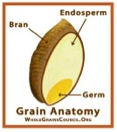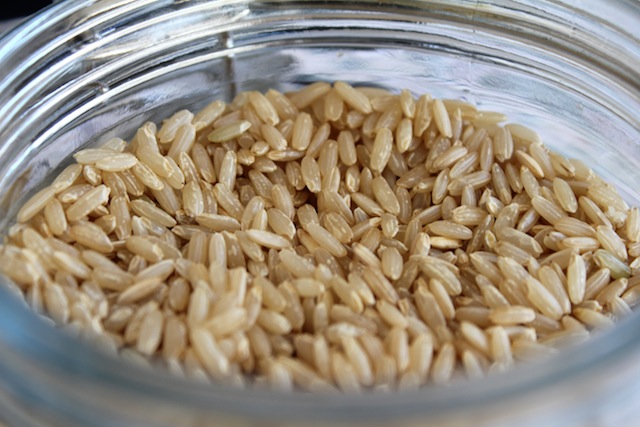The wonder of whole-grains
Whole-grain foods play a part in lowering the risk of heart disease diabetes and certain cancers. See how you can add it into your daily intake.
BY: Lauren Ho
Many Singaporeans have heard about the goodness of whole-grains and know that they are better for our health, than their refined counterparts. But sadly, few are willing to make the change, from refined to whole-grains. Why? In their opinion, whole-grains taste unpalatable and are gritty in texture. Conversely, whole-grain lovers like me, love them for their nutty flavour and chewy texture. If you are not a whole-grain convert yet, I hope that you will be after reading this article.
What are whole grains?
 As their name implies, they are grains or foods made from them that retain all three components – namely the bran (the outer layer), endosperm (the middle layer), and germ (the embryo) in their original proportions (see illustration on the right).
As their name implies, they are grains or foods made from them that retain all three components – namely the bran (the outer layer), endosperm (the middle layer), and germ (the embryo) in their original proportions (see illustration on the right).
Refined grains, on the other hand, are milled to remove the bran and germ, leaving the endosperm. This removes the nutrients that are naturally present in whole-grains, making refined grains nutritionally inferior to whole-grains.
Why whole-grains?
Whole-grains are rich in dietary fibre, vitamins, minerals, phytochemicals*, and good fats. Current clinical studies support the roles of whole-grains in reducing the risk of developing heart disease and stroke, and protecting against diabetes and other non-communicable diseases. A recent study found a link between fibre consumption (from whole-grains) and a reduced risk of death from respiratory diseases (such as pneumonia and chronic bronchitis) and infectious diseases.
|
Components of whole-grains |
Key nutrients |
Potential health benefits |
|
Bran |
Dietary fibre, B vitamins, minerals, phytochemicals* |
Together, these nutrients act synergistically to lower the risk of:
|
|
Endosperm |
Carbohydrate, protein |
|
|
Germ |
B vitamins, vitamin E, protein, good fats, trace minerals, phytochemicals* |
* Phytochemicals are non-nutrient compounds found in plant-derived foods that have protective or disease-preventive properties.
Examples of whole-grains
Whole-grains are more than just unpolished rice (red, brown and black), oats and foods made from whole grain flours such as chapati, brown rice vermicelli, whole-wheat breads and wholemeal pastas. More and more Singaporeans are now enjoying the unique tastes, flavours and textures of less common, more exotic whole-grains such as amaranth, quinoa, bulgur (cracked wheat), buckwheat (soba), millet, whole-grain couscous and wild rice.
How to tell if a product is or contains whole-grains?
The easiest way to decipher this is to look for products that carry:
- The Whole-grains Healthy Choice Symbol (HCS) logo.
- The terms ‘whole-grain’ or ‘whole-wheat’ on their product labels. Examples are whole-grain breakfast cereals and whole-wheat bread.
Alternatively, check the ingredient list, which lists ingredients in a descending order, by weight. For example, if a noodle lists whole-grains such as brown rice, soba or quinoa among its first items in the ingredient list, it is a whole-grain noodle.
How much whole-grains should we eat daily?
For good health, we are advised to consume at least two to three servings of whole-grains daily. This is about half of the five to seven daily servings of rice and alternatives recommended for adults. Examples of one serving of whole-grains include:
- 1/2 bowl of cooked unpolished rice
- 2/3 bowl of raw oats
- 2 slices of wholemeal bread
- 2 chapatis
- 4 whole-wheat biscuits
How to incorporate whole-grains into our diet?
Here are some ways to enjoy whole-grains:
1) For breakfast:
– Replace white breads with whole-wheat breads or wholemeal wraps for a hearty sandwich made with some lean protein (e.g. tuna in water or a hard-boiled egg), fresh tomatoes, lettuce, and 1/4 avocado.
– Tuck into a bowl of oatmeal topped with some chopped nuts, and a sprinkle of seeds and dried fruits.
2) For lunch or dinner:
– Try half and half of white and brown or red rice. Gradually increase the proportion of brown or red rice, as you become accustomed to their taste and texture.
– Substitute plain noodles or pasta with brown rice vermicelli or wholemeal pasta.
– Whip up a quinoa or bulgur salad with some beans, shredded vegetables and lean chicken or fish.
– Add oats to some minced lean meats, lentils and finely chopped vegetables for some hearty home-made burgers or meatballs.
3) For snacks:
– Use wholemeal flour instead of white flour for your home-made pancakes or muffins.
– Enjoy some wholemeal biscuits or crackers or a cup of oatmeal.
– Pop some popcorns but go easy on the oil, sugar and salt.
The evidence is compelling. You have nothing to lose, but everything to gain, if you jump on the bandwagon of whole-grains and take the ride towards better health.
|
DID YOU KNOW? – Quinoa has a higher protein content than most other whole grains and its protein is of an exceptional quality – a complete protein similar to that of animal foods. – Bulgur is a parboiled wheat. This means that it is partially cooked and can be conveniently prepared by adding boiling water in a ratio of one part bulgur to two parts water, and covering it for at least 30 minutes, to soften the grains. – Instant and rolled oats are both whole-grains, even though the former is flaked and ground. – Pearl barley is not a whole-grain, as the hull has been removed and the grain has been polished or “pearled”, giving it a smooth and white exterior. Whole-grain versions are hulled and hulless barley which are not widely available in Singapore. – Not all wholemeal breads are whole-grains, as they may not contain the whole of the wheat-grain but bran added to white flour. These are still better than white breads |
Lauren Ho is a dietitian/nutritionist for the Singapore Heart Foundation. With over 20 years of experience in the field of dietetics and nutrition, she is regularly called upon to conduct nutrition talks and seminars as well as execute and manage nutrition education and marketing projects for several corporate clients.
(** PHOTO CREDITS: Brown rice, bxd, stock.xchng; wild rice, davidlat, stock.xchng; and fresh bread, lusi, stock.xchng)





0 Comments